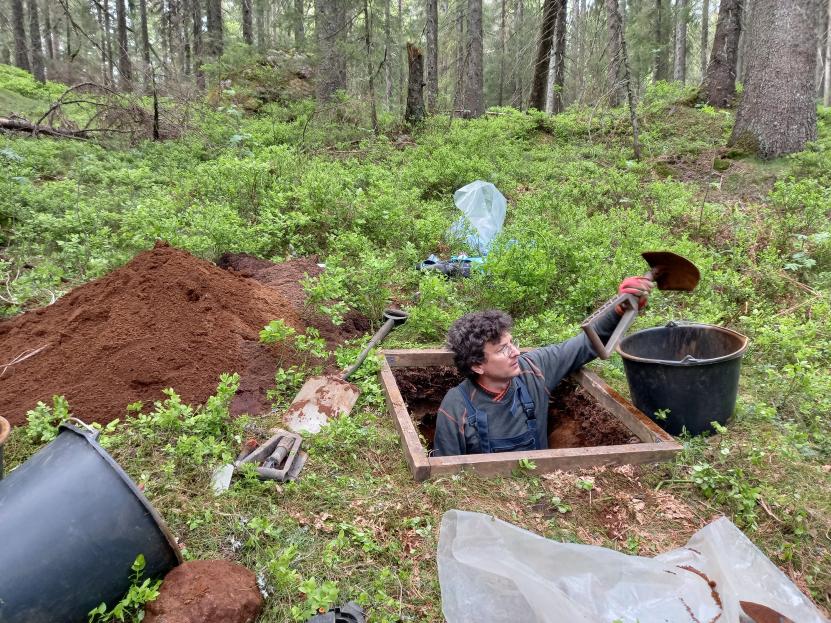The Czech Geological Survey (CGS) is involved in landscape biogeochemistry research. The research focuses on ecological problems caused by natural geochemical and biochemical interactions between rocks in the Earth‘s crust, soil, groundwater, surface water and the atmosphere, and by changes in the environment induced by human activity. The changes include rising air temperature, decreased water availability and frequent periods of extreme drought or extreme torrents of water due to heavy and uneven precipitation. These problems are worsen by groundwater, surface water and soil contaminated with fertilizers, heavy metals and toxic organic substances, which are hazardous to nature and humans in elevated concentrations.
Landscape biogeochemistry
Landscape biogeochemistry in an era of climate change
The research on current ecological problems is based on a long-term observation of the balance of biogenic elements in small forest catchments with areas of tens to hundreds of hectares. A continuous long-term monitoring of this substance balance makes it possible to determine the influence of atmospheric deposition of sulphur and, particularly, nitrogen on soil quality and on the eutrophication and acidification of surface water. The results of the monitoring are used to study the relationship between the parameters of climate change and changes in biogeochemical variables. These primarily include changes in atmospheric deposition, hydrological balance and subsequent cataclysms, such as bark beetle gradation and forest fires in recent years. In many areas, these abrupt changes are altering the character of the landscape, particularly of sensitive ecosystems such as wetlands, mountain forests and natural treeless areas.

Changes in the cycle of carbon and other elements in ecosystems due to environmental change
Research focuses on the transport, accumulation and degradation of anthropogenic pollutants in forest ecosystems and wetlands. The results allow for analysis of the evolution of forests left without intervention as an indicator of the global climate change impact on ecosystem function. Predictive biogeochemical models help monitor the sustainability of landscape evolution. The research includes interactions between microbial and other biological and geochemical processes in soils. Field and laboratory experiments are used to study the interconnection of individual biogeochemical processes. The impact of drought on the flux of environmentally important elements (particularly nitrogen, carbon, phosphorus, calcium and magnesium) in forest ecosystems is being quantified. The ratios of stable isotope abundance ratios for biogenic elements are used to verify the magnitude of greenhouse gas fluxes at the biosphere-pedosphere-hydrosphere interface. The research focuses on sources and sinks of dissolved organic carbon, nitrogen or base cations. Dendrochronological study of Central Europe‘s main tree species combined with biogeochemical analyses and data from small catchments are employed to reconstruct and predict the basic trends in tree vitality, such as respiration, water transport, nutrient use, and thus also the resilience to the expected climate change.
The CGS studies the nutrient cycle on research plots and in forest catchments using isotopes of magnesium, calcium, nitrogen and sulphur. The research also focuses on factors affecting the availability of phosphorus for vegetation and aquatic ecosystems. Biogeochemical experiments on research plots clarify the causes of temporal and spatial changes in industrial pollution. Holistic studies link remote sensing methods with the ecology of selected plant communities. Additional research will focus on microbial methanogenesis associated spatially with mining impacts and inadequately plugged exploration boreholes, and on microbial activity within the biogeochemical processes in soil.
Modelling biogeochemical processes in the landscape
The development of a hydrological-biogeochemical modelling platform enables the modelling of changes in the carbon and nitrogen cycle in soil, water and vegetation that are related to climate change. The model illustrates the temporal as well as spatial extent. The novelty of this platform lies in the integration of hydrological, biogeochemical, forest growth and biodiversity evolution models that were used separately thus far. The modelling includes carbon, nitrogen, base cation and aluminium cycles. The model is being tested over the long term on the small catchments of the GEOMON network and also on Norwegian and Swedish catchments monitored over a long period. The hydrochemical, biogeochemical and hydrological models, which are being used, are included in the publications of CGS staff members: MAGIC, SAFE, PnETBGC/CHESS, SAST, SUNFLOW, pBDM, Brook90, PIHM, SWAT and SAC-SMA. This part of the research produces long-term predictions of changes in the hydrology and soil and water chemistry in forested catchments and wetlands.
Stable isotopes as a diagnostic tool in biogeochemistry
Stable isotope abundance data can be used to determine the sources of nutrients and toxic elements in ecosystems. Stable isotopes of metals serve as diagnostic indicators and tracers of pollution sources. The CGS uses the stable isotopes of chromium, cadmium, lead, zinc, copper and strontium. The data serve to identify processes in individual environmental compartments. The abundance of stable isotopes indicates the sources of chemical elements and compounds in the case when these sources differ in their isotopic composition and when isotopic fractionation does not occur. Such isotopic data are used to find previously unknown sources and sinks of greenhouse gases. The isotopic data helps investigate the transformation of the reactive forms of nitrogen and carbon. The study of stable isotopes focuses on the biogeochemical cycles of light elements (H, C, N, O, S), medium-heavy and heavy elements (Pb, Sr), and on using the Zn, Cu, Cd and Cr isotope systems as natural environmental tracers. Measurement of magnesium isotopes is commencing in forest ecosystems. This research programme will include the development of other applications for stable isotopes in biogeochemistry, forensic science, archaeology, biotechnology testing and in the study of natural energy sources.


